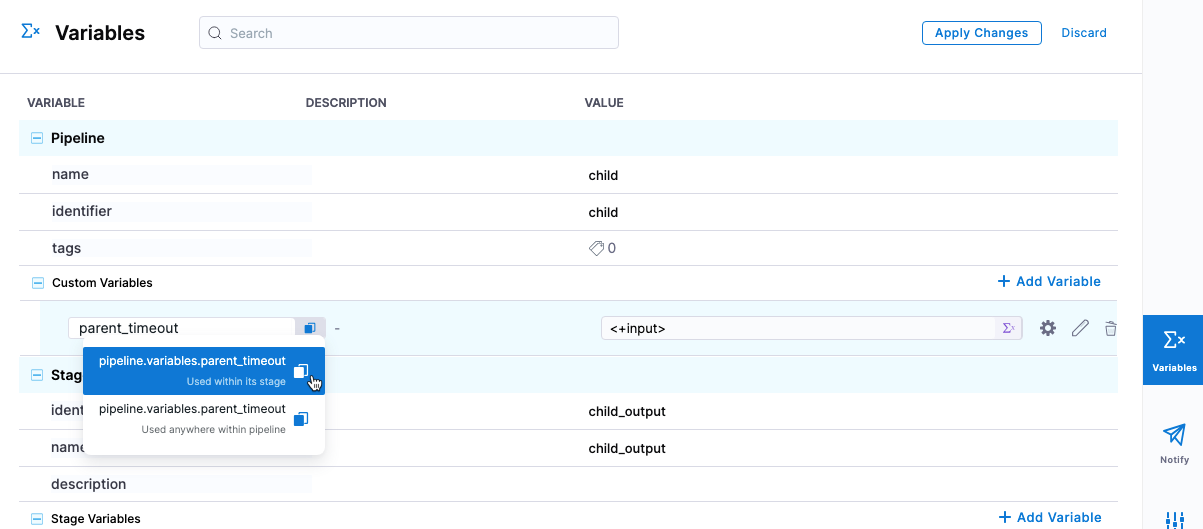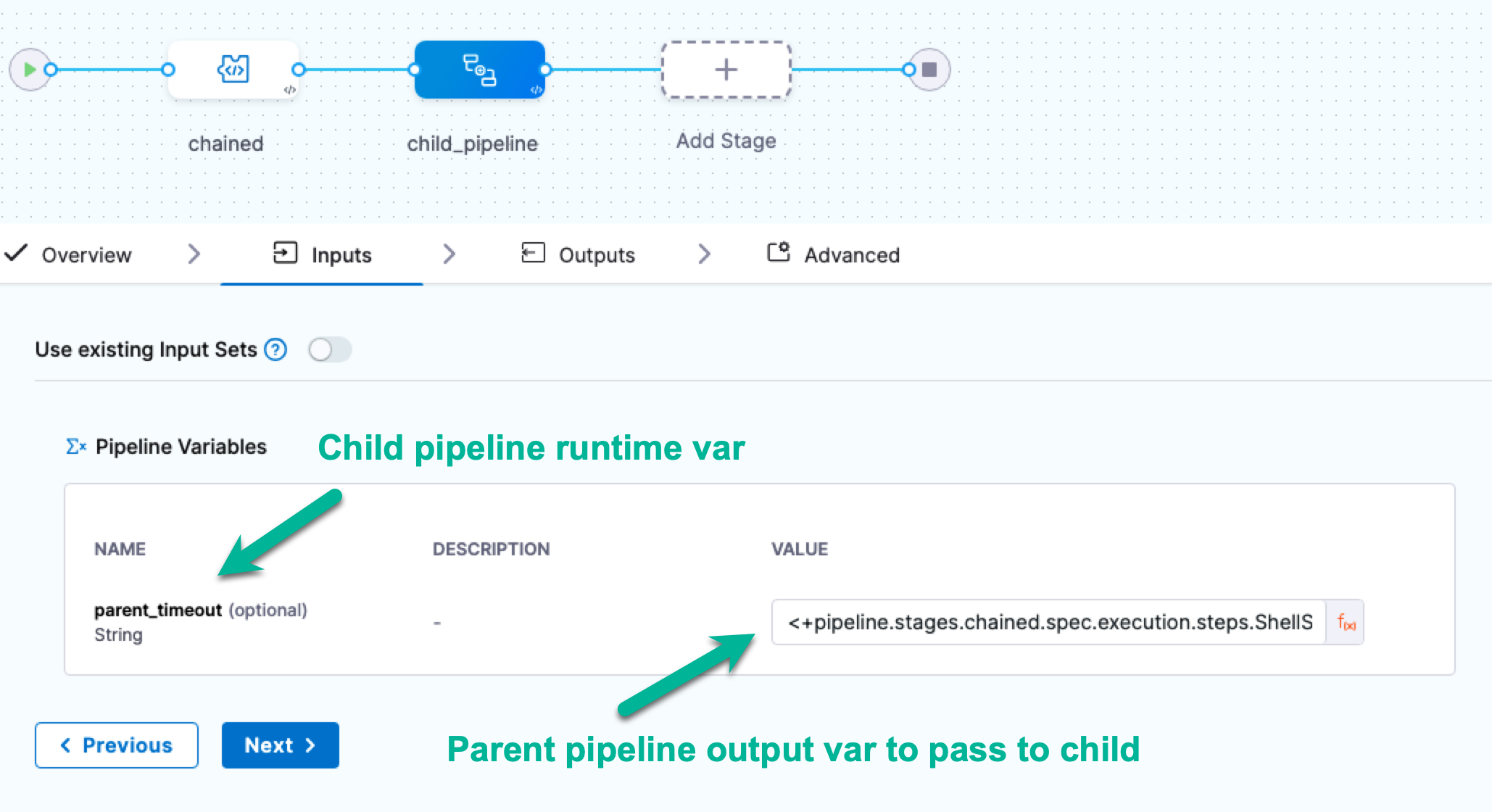Pipeline chaining in Harness
Pipeline chaining involves using the output of one pipeline as input for another. You can link multiple processing steps together and execute them sequentially, creating a more complex workflow.
For example, you could have a pipeline that deploys an application to a test environment. This could be followed by a pipeline that runs a set of integration tests and, finally, a pipeline that deploys the application to production. Each pipeline in the chain is triggered by the completion of the previous pipeline. The output of each pipeline is passed to the next pipeline in the chain. This way, you can automate the whole process and make sure that the application is tested properly before deploying to production.
Chaining pipelines in Harness offers the following benefits:
- Development of complex workflows involving multiple stages of deployment, testing, and verification.
- Ease of handling errors. Visibility into the deployment process makes it easier to identify and troubleshoot issues.
- Faster and more efficient deployment.
- Reusability of the pipeline across multiple applications and environments, reducing the need to recreate the same steps for each deployment.
- Improved collaboration and communication by allowing different teams to work on different stages of the deployment process.
- Enable greater compliance with regulatory requirements and industry best practices through automatic deployments.
Requirements and considerations
- You need read permissions for the child (chained) pipeline and edit permissions for the parent (primary) pipeline to add a chained pipeline (a pipeline stage) to a pipeline.
- To manually run chain pipelines, you need execute permissions for the parent and child pipelines to ensure successful execution.
- If you change the runtime inputs in a chained pipeline, select Inputs in the parent pipeline to see the changes.
- When manually running a pipeline, the pre-flight checks don't validate child pipelines.
- Pipeline stages (chained pipelines) don't support matrix strategies.
- Pipeline stages don't support auto-suggested expressions in Outputs.
- Artifacts, test results, and other output produced by chained pipelines are available in the execution details for the chained pipeline that produced those outputs. This information is not stored in the parent pipeline's execution details.
- Nested pipeline chaining is not supported. When the referred pipeline invokes a child pipeline, it cannot be included within another pipeline.
Chain pipelines
To chain pipelines in Harness:
-
Create each pipeline that you want to chain together, including a parent pipeline where you'll link the child pipelines.
-
To chain pipelines, go to the parent pipeline, select Add Stage, and then select Pipeline.

-
Select the child pipeline that you want to chain to the parent. You can select any pipeline that you can access across different orgs and projects in your Harness account.
-
Select Apply Selected.
-
Repeat the above steps to continue chaining pipelines as needed, and then save the parent pipeline.
In the final chained pipeline stage, you can add concluding steps, such as a Deploy step if you need to deploy an application.
-
Harness recommends running the pipeline in a development environment to test it before executing it in production.
Use parent output in child pipelines
You can use Harness expressions to reference output from a parent pipeline as input in a child pipeline stage.
To use the output of a parent pipeline in the child pipeline and its stages:
-
In the child pipeline, select Variables. You need to create a child pipeline variable so that when you add the child pipeline to the parent pipeline as a stage, the child pipeline stage will have an input you can use to map output variables from the parent pipeline.
-
Under Pipeline, in Custom Variables, select Add Variable.
-
Enter a name for the variable and set its value as a runtime input, and copy the variable expression.

-
Select Apply Changes.
-
Use the expression in the child pipeline wherever you want to use the parent output variable.
-
Save the child pipeline.
-
In the parent pipeline, verify that you have an output variable to pass to the child pipeline. For example, a Shell Script step output variable.
-
In the parent pipeline, select/add the child pipeline stage. The runtime pipeline variable you added to the child pipeline appears in the Inputs tab.

-
In Inputs, you should see the runtime input from the child pipeline variable you created.
-
In Value, enter an expression that references the parent pipeline output variable you want to pass to the child pipeline.
The Inputs tab supports auto-suggested expressions, but these are not available in the Outputs tab.
When the parent pipeline runs and the child pipeline is executed, the child pipeline uses the pipeline-level runtime variable. That variable is resolved using the value from the parent pipeline output variable.
YAML Example: Chained pipelines using variables
Here's an example of a child and parent pipeline where a parent pipeline output expression is mapped and used in a child pipeline stage.
pipeline:
name: child
identifier: child
projectIdentifier: CD_Docs
orgIdentifier: default
tags: {}
stages:
- stage:
name: child_output
identifier: child_output
description: ""
type: Custom
spec:
execution:
steps:
- step:
type: ShellScript
name: ShellScript_1
identifier: ShellScript_1
spec:
shell: Bash
onDelegate: true
source:
type: Inline
spec:
script: echo <+pipeline.variables.parent_timeout>
environmentVariables: []
outputVariables: []
timeout: 10m
outputs: []
tags: {}
variables:
- name: parent_timeout
type: String
description: ""
required: false
value: <+input>
Parent pipeline with child pipeline stage
pipeline:
name: parent
identifier: parent
projectIdentifier: CD_Docs
orgIdentifier: default
tags: {}
stages:
- stage:
name: chained
identifier: chained
description: ""
type: Custom
spec:
execution:
steps:
- step:
type: ShellScript
name: ShellScript_1
identifier: ShellScript_1
spec:
shell: Bash
onDelegate: true
source:
type: Inline
spec:
script: timeout=<+pipeline.stages.chained.spec.execution.steps.ShellScript_1.timeout>
environmentVariables: []
outputVariables:
- name: parent_timeout
type: String
value: timeout
timeout: 10m
outputs: []
tags: {}
- stage:
name: child_pipeline
identifier: child_pipeline
description: ""
type: Pipeline
spec:
org: default
pipeline: child
project: CD_Docs
outputs: []
inputs:
identifier: child
variables:
- name: parent_timeout
type: String
value: <+pipeline.stages.chained.spec.execution.steps.ShellScript_1.output.outputVariables.parent_timeout>
Considerations when executing remote chained pipelines
Consider the following points for executing remote (stored in SCM) chained pipelines:
- A chained pipeline is fetched from the default branch when the parent pipeline is defined inline, and the chained pipeline is defined remotely.
- When the parent pipeline is defined remotely, and the chained pipeline is defined inline, the parent pipeline is fetched from the corresponding branch, and the chained pipeline is fetched inline.
- When both the chained pipeline and the parent pipeline are defined remotely, but under the same repository, the chained pipeline should belong to the same branch as the parent pipeline.
- A chained pipeline is fetched from the default branch when both the parent and chained pipelines are defined remotely in separate repositories. This is irrespective of the branch of the parent pipeline.